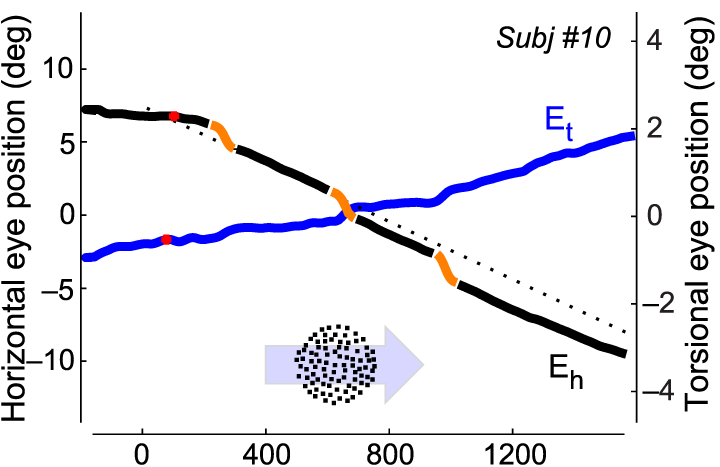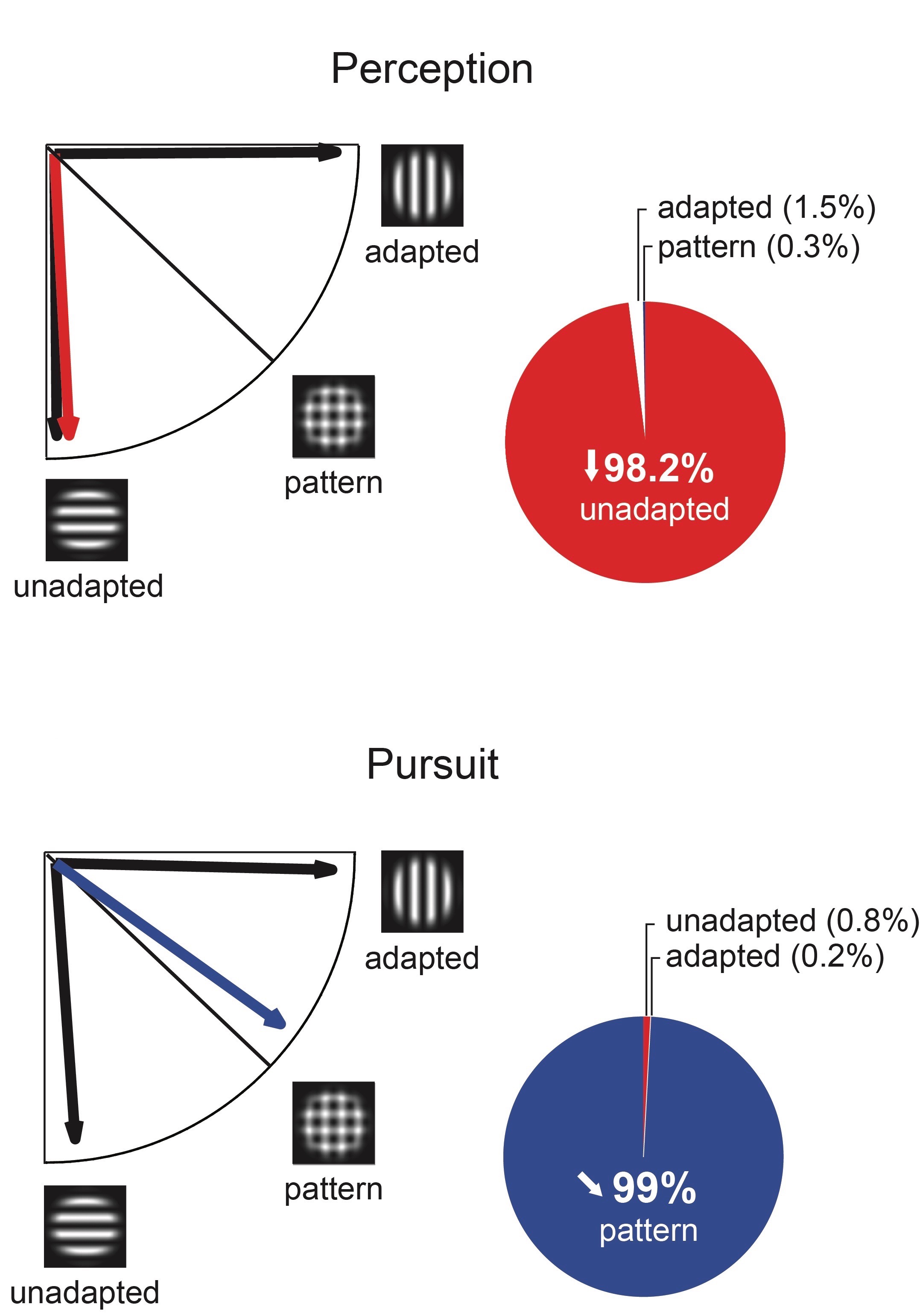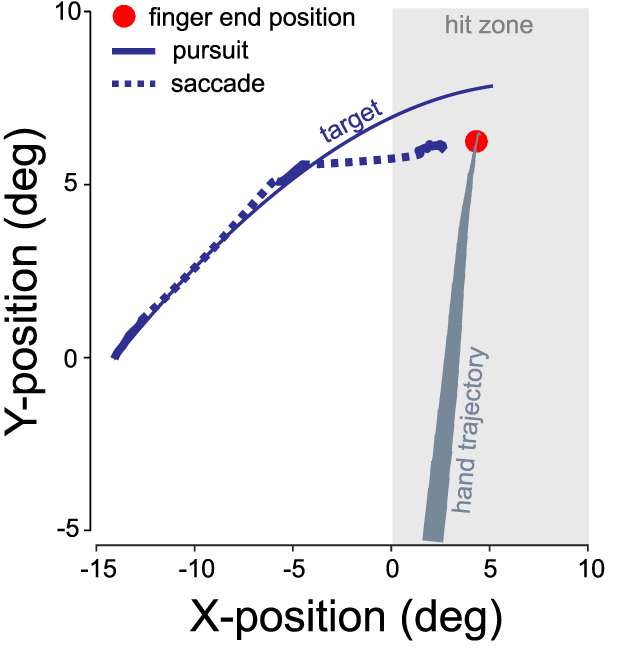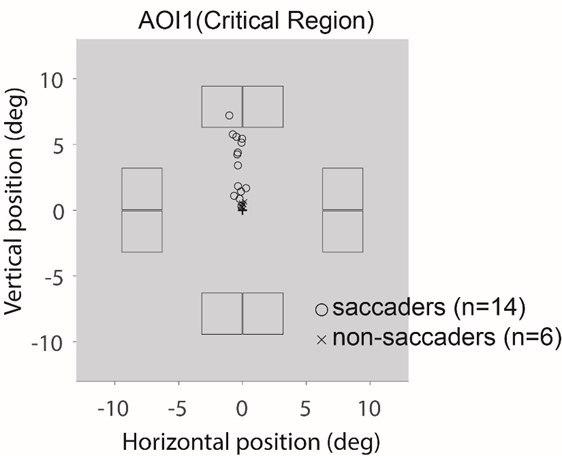Oculomotor Lab
Dr. Miriam Spering
Research in the lab focuses on the interaction between visual perception, cognition, and eye movements. Some research projects focus on how vision control eye movements, and how eye movements in turn affect vision. In other research projects, we use eye movements as a model system to elucidate our understanding of sensorimotor or cognitive processes.
Control of eye movements
To actively explore our dynamic visual environment, we rely on different types of eye movements. Our lab is particularly interested in how the brain controls smooth pursuit eye movements (slow, continuous rotations of the eye to track moving objects), saccades (quick eye movements that shift gaze between objects of interest), and torsion (rotations of the eyes about the line of sight). Current projects investigate the visual signals driving eye movements, and how eye movements respond to naturalistic visual stimuli. We use detailed analyses of eye movement kinematics to provide behavioural evidence for sensorimotor processes underlying eye movement control.
Recent Papers:
- Edinger et al., Invest Ophthalmol Vis Sci, 2017
- Rothwell et al., J Vis, 2020
- Chow et al., J Vis, 2021
Eye movements & perception
Eye movements and perception are closely related. Our previous research on smooth pursuit eye movements has provided evidence for correlations and correspondence between both behaviours, indicating common processes (Spering & Montagnini, 2011) as well as striking dissociations, indicating separate processes (Spering & Carrasco, 2015). Current research in the lab further explores the link between different types of eye movements, including torsion and visual perception. This research largely focuses on healthy brain processes, but we have also applied our paradigms in patient studies. The lab maintains active collaborations with UBC neurologists Drs. Martin McKeown and Thalia Field.
Recent Papers:
- Ming et al., Invest Ophthalmol Vis Sci, 2016
- Wu & Spering, J Vis, 2019
- Wu et al., J Neurophysiol, 2021
Eye movements & action
In this line of research, our aim is to relate eye movement kinematics to visual prediction and action outcomes, such as manual reaching or interception. Studying eye movements in combination with hand movements provides important insights into sensorimotor processes critical for accurate decision making, and for the control of goal-directed actions. We aim to develop ecologically valid paradigms that can be linked to real-world eye-hand coordination, for example, in baseball and other interceptive sports contexts. We collaborate with Dr. Nicola Hodges (UBC Kinesiology) and the UBC Baseball Team.
Recent Papers:
- Fooken et al., J Vis, 2016
- Kreyenmeier et al., J Neurophysiol, 2017
- Fooken et al., J Vis, 2018
- Fooken & Spering, J Vis, 2019
- Fooken & Spering, J Neurophysiol, 2020
- Fooken et al., Vis Res, 2021
Eye movements & cognition
Eye movements are continuous and can be used as a sensitive read-out of time-critical cognitive processes. Some research studies in the lab have linked the velocity, amplitude, or direction of pursuit or saccadic eye movements to the processing of feature-based attention, the expectation of reward, or the retrieval of information from visual working memory. The lab has a long-standing collaboration with Dr. Anna Montagnini (CNRS Marseille, Aix-Marseille Université, France) and also collaborates with Dr. Martin Rolfs (Humboldt University Berlin, Germany).
Recent Papers:
- Spering & Carrasco, J Neurosci, 2012
- Brielmann & Spering, J Exp Psychol: Hum Percept Perform, 2015
- Kinjo et al., Vis Res, 2020
Cross-cultural psychology
In 2001, when Miriam was an undergraduate student at Heidelberg University, she wrote a paper for the Boston Consulting Group, entitled "Current issues in cross-cultural psychology: research topics, applications, and perspectives". Somehow, this paper has found its way into the www and has been cited quite frequently. Here is a [pdf] for download; please cite it as Spering, M. (2001). Current issues in cross-cultural psychology: research topics, applications, and perspectives. Unpublished manuscript, obtained from http:// visualcognition.ca/spering/research.html, [enter date downloaded].






